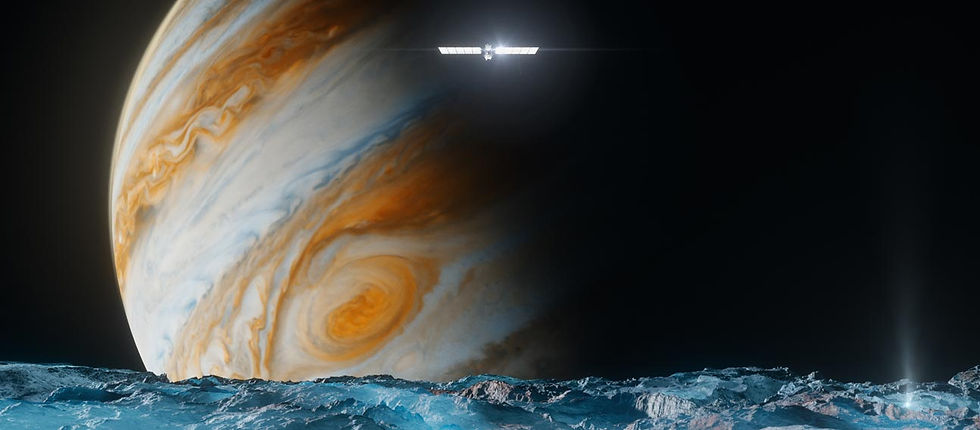Still, there are mysteries below our sky: Misunderstanding in Art

This week, I was reminded of this peculiar power of suggestion when I encountered the poem "In Praise of Mystery: A Poem for Europa" by Poet Laureate Ada Limón. The poem was discussed in an NPR interview with the author. She was asked to describe what it was like to write a poem knowing that it would be inscribed on a spacecraft and sent towards Jupiter's icy moon.
The interview featured a recording of her reading the poem out loud, and the first words I heard of the actual poem were:
Still, there are mysteries below our sky
the whale song, the songbird singing its call in the bough of a wind-shaken tree.
This caught me off guard- to begin a poem with the words Still, there are mysteries below our sky (knowing this poem is about a mission to space) says something powerful. We are implicitly invited to seek footing in the first line of a poem. To being a poem with the words Still there are- means that the poem exists in a context that is ongoing. The context that proceeds such a poem is... your lifetime of experiences. It's as if to say While you were doing whatever you've been doing- STILL there are mysteries... there never ceased to be, and they continue to puzzle us- below OUR sky. You and Me, whoever we are, and whatever we do in the endless flow of existence- STILL there are mysteries...
That line reminded me that human existence is long and full of curiosity and that we are creatures who habitually seek and discover mystery. (which clearly was the intent.)
Knowing this was written for a mission to Jupiter's icy moon, I was struck by the decision to begin the poem in a completely different place. Looking not upward, but forward- at what exists below our sky. In the realm where we exist and move and create things. It forced me to reconcile, Yes, there are boundless and enduring mysteries in our world... but (you and I both know) this poem isn't about that. It's about the pursuit of yet ANOTHER mystery, far away from our world in deep space...
Naturally I had to read this full poem.
... I quickly discovered that Still, there are mysteries below our sky is *not,* in fact, the first line of the poem... It is actually the first line of the third stanza, where the editor of the interview chose to cut in.
The true opening line reads, Arching under the night sky inky... Which makes much more sense as an introduction. It grounds the reader and nudges them towards an exploration of the vast mysteries of space in a way that is inviting, curious, mysterious, and enticing. This line lures the reader in with urgency, Arching (a present tense verb), and compels you to explore deeper into the unknown opacity, inky...
I absolutely love this poem. I found myself tearing up while reading it for the first time, and I tear up, still, reading it now. I will not endeavor, here, to give a full breakdown of why this poem is excellent, but I strongly encourage you to read it for yourself ❤️
It is an artists mission to interrogate and pursue powerful experiences with the intent synthesizing and creating new work. In this pursuit, I do not think it's right to discount experience and epiphanies born out of misunderstanding. Misunderstanding can be a powerful force for artistic and creative generation. Believing you are seeing something as it was intended can encourage you to make sense of something in a totally new and interesting way. There have been many times in my life as an artist where I found this kind of 'productive misunderstanding' to be extremely fruitful.
These moments put ideas in your head that are radical and new and push a genera forward- simply because you thought (for a moment) that the genera was already there! You suddenly discover a whole new expressive capability of a medium. It is easy to believe that something new and powerful can exist in art if you've accidentally convinced yourself that it already has existed.
Just because the original author did not intend the exact experience you had, it doesn't mean that your experience of the work cannot be meaningful or inspire you. To be an artist, you must have faith that your experience as a viewer can be replicated, and that new work can be made from them. This isn't to say that the artists intent does not matter- I believe it is appropriate and important to consider and appreciate a work as it was meant to be viewed, but not to let that experience be the final arbiter of what you can learn through your individual exploration of the piece. The author Charles Dewey postulates that all works of art are unilaterally characterized by their capacity to generate meaningful experiences over, and over again.
Just because the original author did not fully mean for you to see whatever you saw- it doesn't mean that you can't deliberately craft whatever experience you had for someone else in the future.